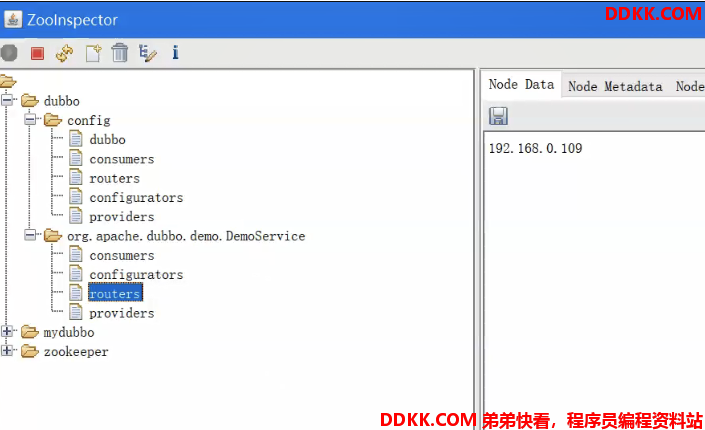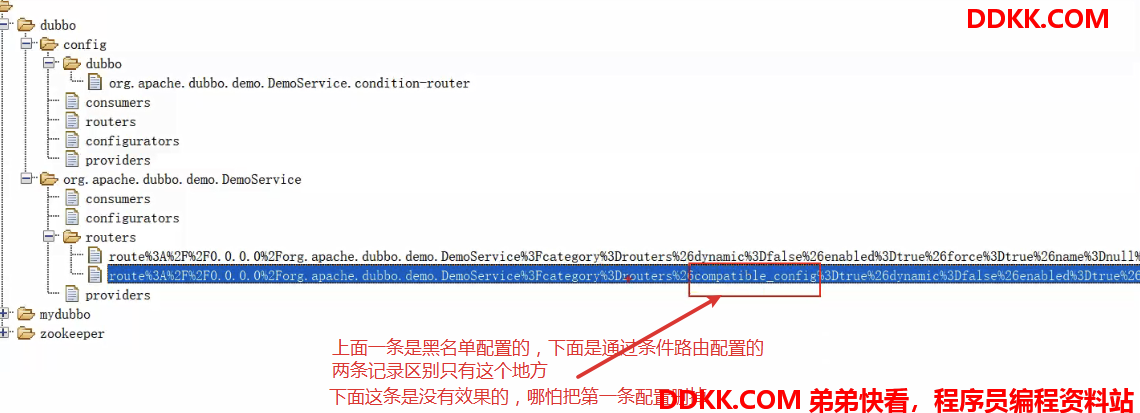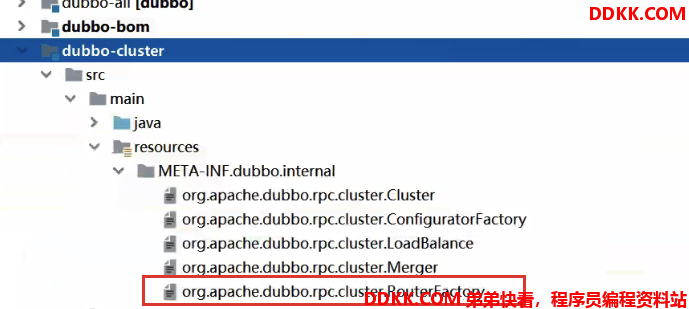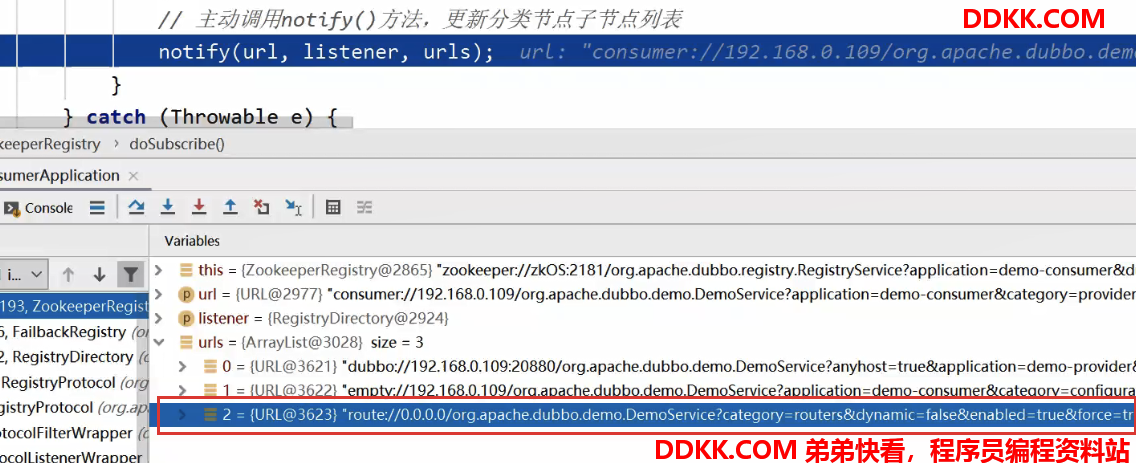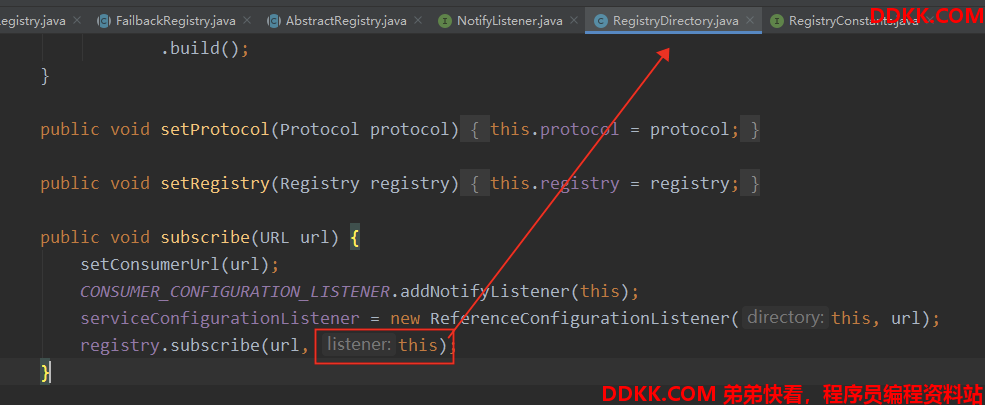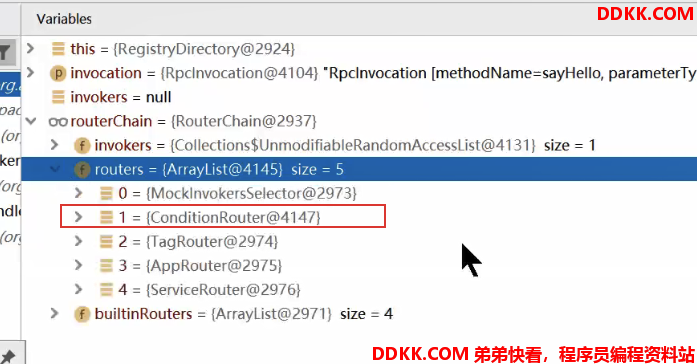服务路由源码解析
1. 什么是服务路由
服务路由包含一条(或若干条)路由规则,路由规则决定了服务消费者的调用目标,即规定了服务消费者可调用哪些服务提供者。Dubbo 目前提供了三种服务路由实现,分别为条件路由ConditionRouter、脚本路由 ScriptRouter 和标签路由 TagRouter。其中条件路由是我们最常使用的。
下面将以条件路由为例来讲解服务路由的用法。
2. 路由规则的设置
路由规则是在 Dubbo 管控平台 Dubbo-Admin 中的。
(1) 启动管控平台
A、启动管控台
将dubbo-admin-0.1.jar 文件存放到任意目录下,例如 D 盘根目录下,直接运行。
注意这里的 dubbo-admin 是已经配置好的。具体配置详见《Dubbo(二)入门 Dubbo 管理控制台》。

B、 访问
在浏览器地址栏中输入 http://localhost:8080 ,即可看到 Dubbo 管理控制台界面。
(2) 设置路由规则
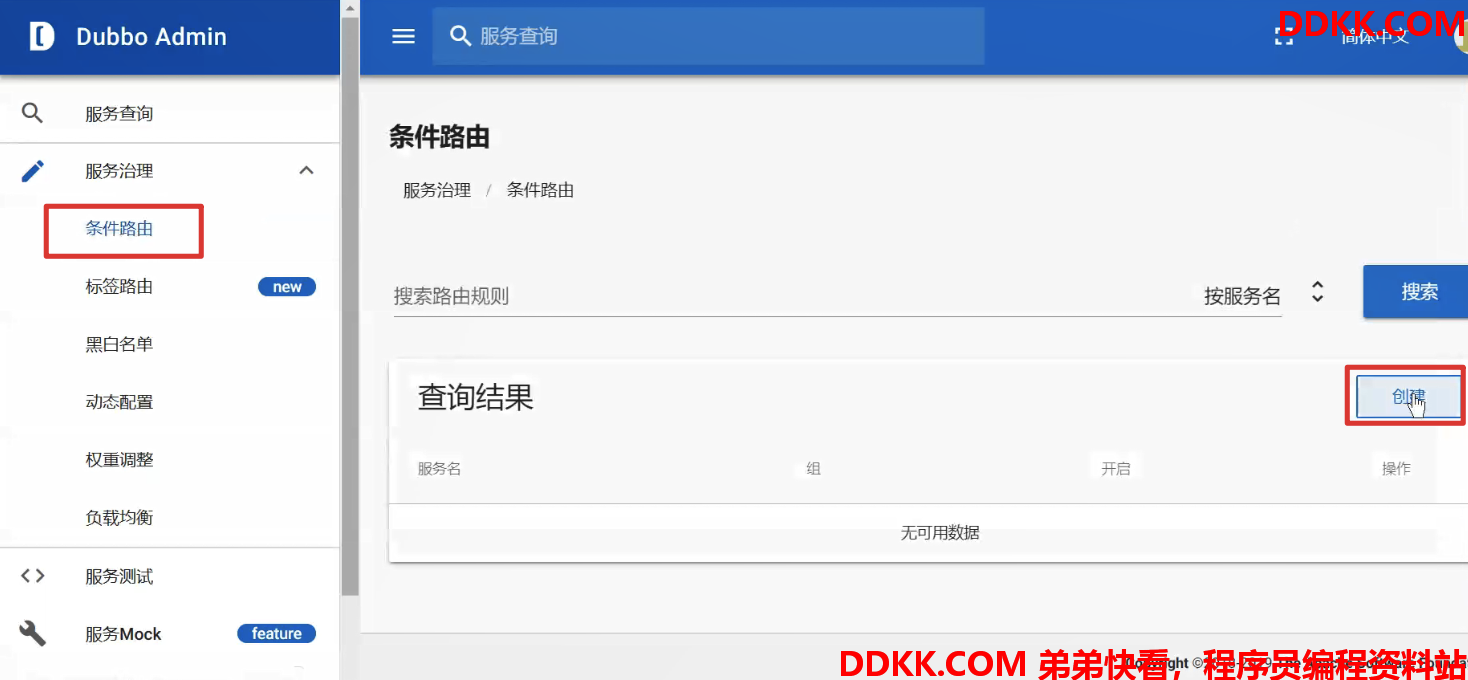
点击创建:
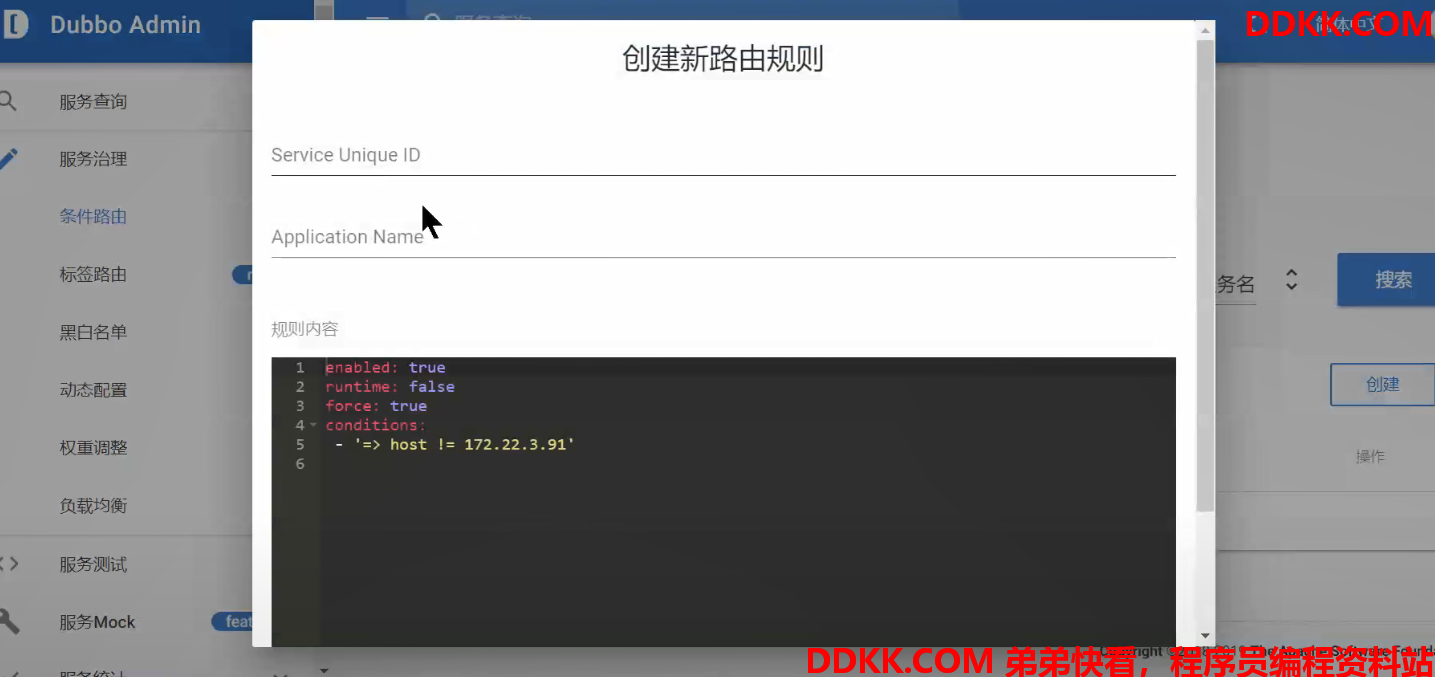
就在这里设置路由规则。
3. 路由规则详解
(1) 初识路由规则
应用粒度路由规则:
scope: application
force: true
runtime: true
enabled: true
key: governance-conditionrouter-consumer
conditions:
# app1 的消费者只能消费所有端口为 20880 的服务提供实例
- application=app1 => address=*:20880
# app2 的消费者只能消费所有端口为 20881 的服务提供实例
- application=app2 => address=*:20881
服务粒度路由规则:
scope: service
force: true
runtime: true
enabled: true
key: org.apache.dubbo.samples.governance.api.DemoService
conditions:
# DemoService 的 sayHello 方法只能消费所有端口为 20880 的服务提供者实例
- method=sayHello => address=*:20880
# DemoService 的 sayHi 方法只能消费所有端口为 20881 的服务提供者实例
- method=sayHi => address=*:20881
(2) 属性详解
A、 scope
必填项。表示路由规则的作用粒度,其取值将会决定 key 的取值。其取值范围如下:
- service:表示服务粒度
- application:表示应用粒度
B、 Key
必填项。指定规则体将作用于哪个服务或应用。其取值取决于 scope 的取值。
- scope 取值为 application 时,key 取值为 application 名称,即
<dubbo:application name=””/>的值。 - scope 取值为 service 时,key 取值为[group:]service[:version]的组合,即组、接口名称与版本号。
C、 enabled
可选项。指定当前路由规则是否立即生效。缺省值为 true,表示立即生效。
D、force
可选项。指定当路由结果为空时,是否强制执行。如果不强制执行,路由结果为空则路由规则自动失效,不使用路由。缺省为 false,不强制执行。
E、 runtime
可选项。指定是否在每次调用时执行路由规则。
- 若为 false 则表示只在提供者地址列表变更时会预先执行路由规则,并将路由结果进行缓存,消费者调用时直接从缓存中获取路由结果。
- 若为 true 则表示每次调用都要重新计算路由规则,其将会直接影响调用的性能。缺省为 false。
F、 priority
可选项。用于设置路由规则的优先级,数字越大,优先级越高,越靠前执行。缺省为 0。
(3) 规则体 conditions
必填项。定义具体的路由规则内容,由 1 到任意多条规则组成。
A、格式
路由规则由两个条件组成,分别用于对服务消费者和提供者进行匹配。
[服务消费者匹配条件] => [服务提供者匹配条件]
- 当消费者的 URL 满足匹配条件时,对该消费者执行后面的过滤规则。
- => 之后为提供者地址列表的过滤条件,所有参数和提供者的 URL 进行对比,消费者最终只拿到过滤后的地址列表。
例如路由规则为:host = 10.20.153.10 => host = 10.20.153.11。其表示 IP 为 10.20.153.10的服务消费者只可调用 IP 为 10.20.153.11 机器上的服务,不可调用其他机器上的服务。
不过,这两个条件存在缺省的情况:
- 服务消费者匹配条件为空,表示不对服务消费者进行限制,所有消费者均将被路由到行后面的提供者。
- 服务提供者匹配条件为空,表示对符合消费者条件的消费者将禁止调用任何提供者。
例如路由规则为:=> host != 10.20.153.11,则表示所有消费者均可调用IP为10.20.153.11之外的所有提供者。
再如路由规则为:host = 10.20.153.10 => ,则表示 IP 为 10.20.153.10 的提供者不能调用任何提供者。
B、 符号支持
参数符号:
- method:将调用方法作为路由规则比较的对象
- argument:将调用方法参数作为路由规则比较的对象
- protocol:将调用协议作为路由规则比较的对象
- host:将 IP 作为路由规则比较的对象
- port:将端口号作为路由规则比较的对象
- address:将 IP:端口号作为路由规则比较的对象
- application:将应用名称作为路由规则比较的对象
条件符号:
- 等于号(=):将参数类型匹配上参数值作为路由条件
- 不等号(!=):将参数类型不匹配参数值作为路由条件
取值符号:
- 逗号(,):多个取值的分隔符,如:host != 10.20.153.10,10.20.153.11
- 星号(*):通配符,如:host != 10.20.*
- 美元符号(
$):表示引用消费者的参数值,如:host =$host
C、 举例
- 白名单
host != 10.20.153.10,10.20.153.11 =>
禁用 IP 为 10.20.153.10 与 10.20.153.11 之外的所有主机。 - 黑名单
host = 10.20.153.10,10.20.153.11 =>
IP 为 10.20.153.10 与 10.20.153.11 的主机将被禁用。 - 只暴露一部分的提供者
=> host = 172.22.3.1*,172.22.3.2*
消费者只可访问 IP 为 172.22.3.1与 172.22.3.2的提供者主机。 - 为重要应用提供额外的机器
application != kylin => host != 172.22.3.95,172.22.3.96
应用名称不为 kylin 的应用不能访问 172.22.3.95 与 172.22.3.96 两台提供者主机。即只有名称为 kylin 的消费者可以访问 172.22.3.95 与 172.22.3.96 两台提供者主机。当然,kylin 还可以访问其它提供者主机,而其它消费者也可以访问 172.22.3.95 与 172.22.3.96 之外的所有提供者主机。 - 读写分离
method = find*,list*,get*,is* => host = 172.22.3.94,172.22.3.95,172.22.3.96
method != find*,list*,get*,is* => host = 172.22.3.97,172.22.3.98
find、list、get、is 开头的消费者方法会被路由到 172.22.3.94、172.22.3.95 与 172.22.3.96
三台提供者主机,而其它方法则会被路由到 172.22.3.97 与 172.22.3.98 两台提供者主机。 - 前后台分离
application = bops => host = 172.22.3.91,172.22.3.92,172.22.3.93
application != bops => host = 172.22.3.94,172.22.3.95,172.22.3.96
应用名称的 bops 的消费者会被路由到 172.22.3.91、172.22.3.92 与 172.22.3.93 三台提供者主机,而其它消费者则会被路由到 172.22.3.94、172.22.3.95 与 172.22.3.96 三台提供者。 - 隔离不同机房网段
host != 172.22.3.* => host != 172.22.3.*
不是 172.22.3 网段的消费者是不能访问 172.22.3 网段的提供者的。即只有 172.22.3 网段的消费者才可访问 172.22.3 网段的提供者。当然,172.22.3 网段的消费者也可访问其它网段的提供者。 - 只访问本机的服务
=> host = $host
$host 表示获取消费者请求中的消费者主机 IP。故该规则就表示消费者只能访问本机的服务。
演示:
有个问题:
将上面通过黑白名单配置的路由规则从ZK中直接拷贝出来,在条件路由中配置:
添加成功后看ZK:
启动代码:
删掉路由规则,提供者端不动,重新启动消费者(因为我们消费者是一个简单Demo不是容器、Web应用,只能重新启动):
发现又成功执行
可以看到这个路由规则是动态配置的。
4. 源码解析
三个关键问题:
- 在哪添加 RouterChain 到 Directory的
- 在哪读取 zk 中的路由规则并添加到 RouterChain 的
- 在哪进行服务路由过滤的
(1) 添加 RouterChain 到 Directory
先看下都有哪些激活的RouterFactory :
找到META-INF/dubbo/internal/org.apache.dubbo.rpc.cluster.RouterFactory文件:
只有最后四个类被@Activate标记
之前我们分析过服务订阅流程,现在只列路径:
org.apache.dubbo.config.ReferenceConfig#init
org.apache.dubbo.config.ReferenceConfig#createProxy
org.apache.dubbo.rpc.Protocol#refer(为每个注册中心虚拟一个invoker)
org.apache.dubbo.registry.integration.RegistryProtocol#refer
org.apache.dubbo.registry.integration.RegistryProtocol#doRefer
//org.apache.dubbo.registry.integration.RegistryProtocol#doRefer
private <T> Invoker<T> doRefer(Cluster cluster, Registry registry, Class<T> type, URL url) {
// 生成一个动态Directory
RegistryDirectory<T> directory = new RegistryDirectory<T>(type, url);
directory.setRegistry(registry);
directory.setProtocol(protocol);
// all attributes of REFER_KEY
Map<String, String> parameters = new HashMap<String, String>(directory.getUrl().getParameters());
URL subscribeUrl = new URL(CONSUMER_PROTOCOL, parameters.remove(REGISTER_IP_KEY), 0, type.getName(), parameters);
if (!ANY_VALUE.equals(url.getServiceInterface()) && url.getParameter(REGISTER_KEY, true)) {
directory.setRegisteredConsumerUrl(getRegisteredConsumerUrl(subscribeUrl, url));
// 将consumer注册到zk
registry.register(directory.getRegisteredConsumerUrl());
}
// 将所有router添加到directory
directory.buildRouterChain(subscribeUrl);
// 订阅服务
directory.subscribe(subscribeUrl.addParameter(CATEGORY_KEY,
PROVIDERS_CATEGORY + "," + CONFIGURATORS_CATEGORY + "," + ROUTERS_CATEGORY));
// 将invoker列表伪装为一个invoker
Invoker invoker = cluster.join(directory);
ProviderConsumerRegTable.registerConsumer(invoker, url, subscribeUrl, directory);
return invoker;
}
关键代码就在这,生成动态列表RegistryDirectory后,调用了directory.buildRouterChain(subscribeUrl)方法:
//org.apache.dubbo.registry.integration.RegistryDirectory#buildRouterChain
public void buildRouterChain(URL url) {
this.setRouterChain(RouterChain.buildChain(url));
}
DEBUG
主要跟RouterChain.buildChain(url):
//org.apache.dubbo.rpc.cluster.RouterChain#buildChain
public static <T> RouterChain<T> buildChain(URL url) {
return new RouterChain<>(url);
}
看RouterChain的构造:
private RouterChain(URL url) {
List<RouterFactory> extensionFactories = ExtensionLoader
// 加载并缓存RouterFactory的所有扩展类(四类)
.getExtensionLoader(RouterFactory.class)
//获取激活的扩展类(之前看了有四个)
.getActivateExtension(url, (String[]) null);
// 遍历RouterFactory列表,每个Factory都会根据url创建一个路由器Router
// 将所有生成的Router形成List集合
List<Router> routers = extensionFactories.stream()
.map(factory -> factory.getRouter(url))
.collect(Collectors.toList());
// 使用Router列表初始化RouterChain
initWithRouters(routers);
}
//org.apache.dubbo.rpc.cluster.RouterChain#initWithRouters
public void initWithRouters(List<Router> builtinRouters) {
//当前是RouterChain,维护了Router列表
this.builtinRouters = builtinRouters;
this.routers = new ArrayList<>(builtinRouters);
//排序(自然排序,Router实现了Comparable接口,底层根据
//org.apache.dubbo.rpc.cluster.Router#getPriority的值进行排序)
this.sort();
}
DEBUG
看下RouterChain
包含的就是之前我们看到的四个激活的 RouterFactory 创建的对应的Router
这四个是属于一开始默认激活的
(2) 读取 zk 中的路由规则并添加到 RouterChain
A、获取 router 子节点 url
先看下zk中关于路由的元数据:
路由规则从ZK中读取的时机,就是我们之前跟服务订阅时,更新providers列表信息一样,还记得有三种分类节点吗:
//org.apache.dubbo.registry.integration.RegistryProtocol#doRefer
private <T> Invoker<T> doRefer(Cluster cluster, Registry registry, Class<T> type, URL url) {
// 生成一个动态Directory
RegistryDirectory<T> directory = new RegistryDirectory<T>(type, url);
directory.setRegistry(registry);
directory.setProtocol(protocol);
// all attributes of REFER_KEY
Map<String, String> parameters = new HashMap<String, String>(directory.getUrl().getParameters());
URL subscribeUrl = new URL(CONSUMER_PROTOCOL, parameters.remove(REGISTER_IP_KEY), 0, type.getName(), parameters);
if (!ANY_VALUE.equals(url.getServiceInterface()) && url.getParameter(REGISTER_KEY, true)) {
directory.setRegisteredConsumerUrl(getRegisteredConsumerUrl(subscribeUrl, url));
// 将consumer注册到zk
registry.register(directory.getRegisteredConsumerUrl());
}
// 将所有router添加到directory
directory.buildRouterChain(subscribeUrl);
// 订阅服务
directory.subscribe(subscribeUrl.addParameter(CATEGORY_KEY,
PROVIDERS_CATEGORY + "," + CONFIGURATORS_CATEGORY + "," + ROUTERS_CATEGORY));
// 将invoker列表伪装为一个invoker
Invoker invoker = cluster.join(directory);
ProviderConsumerRegTable.registerConsumer(invoker, url, subscribeUrl, directory);
return invoker;
}
即directory.subscribe方法:
org.apache.dubbo.registry.integration.RegistryDirectory#subscribe
org.apache.dubbo.registry.RegistryService#subscribe
org.apache.dubbo.registry.support.FailbackRegistry#subscribe
org.apache.dubbo.registry.support.FailbackRegistry#doSubscribe
org.apache.dubbo.registry.dubbo.DubboRegistry#doSubscribe
public void doSubscribe(final URL url, final NotifyListener listener) {
try {
if (ANY_VALUE.equals(url.getServiceInterface())) {
// 处理interface属性为*的情况
...
} else {
// 处理interface属性为真正接口的情况
// 存放所有分类节点下的所有子节点url
List<URL> urls = new ArrayList<>();
for (String path : toCategoriesPath(url)) {
//将url分成三类:providers、routers、configurators
//此时routers是我们需要关注的
ConcurrentMap<NotifyListener, ChildListener> listeners = zkListeners.get(url);
if (listeners == null) {
zkListeners.putIfAbsent(url, new ConcurrentHashMap<>());
listeners = zkListeners.get(url);
}
ChildListener zkListener = listeners.get(listener);
if (zkListener == null) {
listeners.putIfAbsent(listener, (parentPath, currentChilds) -> ZookeeperRegistry.this.notify(url, listener, toUrlsWithEmpty(url, parentPath, currentChilds)));
zkListener = listeners.get(listener);
}
// 在zk中创建分类节点
zkClient.create(path, false);
// 为分类节点添加子节点列表变更的watcher监听
// 并返回其所有子节点列表
List<String> children = zkClient.addChildListener(path, zkListener);
if (children != null) {
// toUrlsWithEmpty()获取当前分类节点下的所有子节点url
// 如果children为空,会生成一个empty的URL
urls.addAll(toUrlsWithEmpty(url, path, children));
}
}
// 主动调用notify()方法,更新分类节点子节点列表
notify(url, listener, urls);
}
} catch (Throwable e) {
throw new RpcException("Failed to subscribe " + url + " to zookeeper " + getUrl() + ", cause: " + e.getMessage(), e);
}
}
DEBUG
看下执行notify时,urls内容:
看下路由相关参数
B、 将路由添加到 directory
继续走notify方法:
org.apache.dubbo.registry.support.FailbackRegistry#notify
org.apache.dubbo.registry.support.FailbackRegistry#doNotify
org.apache.dubbo.registry.support.AbstractRegistry#notify(org.apache.dubbo.common.URL, org.apache.dubbo.registry.NotifyListener, java.util.List<org.apache.dubbo.common.URL>)
protected void notify(URL url, NotifyListener listener, List<URL> urls) {
//url是消费者url,urls是提供者url列表
...
// keep every provider's category.
// key:category
// value:为该category的所有子节点的url
Map<String, List<URL>> result = new HashMap<>();
for (URL u : urls) {
if (UrlUtils.isMatch(url, u)) {
String category = u.getParameter(CATEGORY_KEY, DEFAULT_CATEGORY);
// 为每一个category创建一个List,然后将category作为key,
// 将这个创建的list作用value
List<URL> categoryList = result.computeIfAbsent(category, k -> new ArrayList<>());
// 将当前遍历的url放入到相应的category的list中
categoryList.add(u);
}
}
if (result.size() == 0) {
return;
}
// 为当前消费者url创建一个map,而这个map存的就是上面result中的内容
Map<String, List<URL>> categoryNotified = notified.computeIfAbsent(url, u -> new ConcurrentHashMap<>());
// 遍历所有的category
for (Map.Entry<String, List<URL>> entry : result.entrySet()) {
String category = entry.getKey();
List<URL> categoryList = entry.getValue();
categoryNotified.put(category, categoryList);
// 主动调用当前遍历category的notify(),更新其子节点列表
listener.notify(categoryList);
// We will update our cache file after each notification.
// When our Registry has a subscribe failure due to network jitter, we can return at least the existing cache URL.
saveProperties(url);
}
}
这些代码之前都跟过,继续看listener.notify(categoryList):
//org.apache.dubbo.registry.integration.RegistryDirectory#notify
public synchronized void notify(List<URL> urls) {
Map<String, List<URL>> categoryUrls = urls.stream()
.filter(Objects::nonNull)
.filter(this::isValidCategory)
.filter(this::isNotCompatibleFor26x)
.collect(Collectors.groupingBy(url -> {
if (UrlUtils.isConfigurator(url)) {
return CONFIGURATORS_CATEGORY;
} else if (UrlUtils.isRoute(url)) {
return ROUTERS_CATEGORY;
} else if (UrlUtils.isProvider(url)) {
return PROVIDERS_CATEGORY;
}
return "";
}));
// 处理category为configurators的情况
List<URL> configuratorURLs = categoryUrls.getOrDefault(CONFIGURATORS_CATEGORY, Collections.emptyList());
this.configurators = Configurator.toConfigurators(configuratorURLs).orElse(this.configurators);
// 处理category为routers的情况
List<URL> routerURLs = categoryUrls.getOrDefault(ROUTERS_CATEGORY, Collections.emptyList());
//lambda表达式,toRouters返回的集合不为空
// 则会调用addRouters方法,把自己作为参数
toRouters(routerURLs).ifPresent(this::addRouters);
// providers
// 处理category为providers的情况
List<URL> providerURLs = categoryUrls.getOrDefault(PROVIDERS_CATEGORY, Collections.emptyList());
refreshOverrideAndInvoker(providerURLs);
}
此时我们关注toRouters方法:
public class RegistryDirectory<T> extends AbstractDirectory<T> implements NotifyListener {
...
private static final RouterFactory ROUTER_FACTORY = ExtensionLoader.getExtensionLoader(RouterFactory.class).getAdaptiveExtension();
...
private Optional<List<Router>> toRouters(List<URL> urls) {
if (urls == null || urls.isEmpty()) {
return Optional.empty();
}
List<Router> routers = new ArrayList<>();
for (URL url : urls) {
if (EMPTY_PROTOCOL.equals(url.getProtocol())) {
continue;
}
String routerType = url.getParameter(ROUTER_KEY);
if (routerType != null && routerType.length() > 0) {
url = url.setProtocol(routerType);
}
try {
//核心代码,ROUTER_FACTORY是一个自适应RouterFactory
Router router = ROUTER_FACTORY.getRouter(url);
if (!routers.contains(router)) {
routers.add(router);
}
} catch (Throwable t) {
logger.error("convert router url to router error, url: " + url, t);
}
}
return Optional.of(routers);
}
如果routers不为空,则会执行addRouters方法,将Router添加到routerChain
//org.apache.dubbo.rpc.cluster.directory.AbstractDirectory#addRouters
protected void addRouters(List<Router> routers) {
routers = routers == null ? Collections.emptyList() : routers;
routerChain.addRouters(routers);
}
(3) 服务路由过滤
服务路由过滤是发生在消费者远程调用的时候:
从消费者动态代理类的InvokerInvocationHandler开始追踪:
//org.apache.dubbo.rpc.proxy.InvokerInvocationHandler#invoke
public Object invoke(Object proxy, Method method, Object[] args) throws Throwable {
String methodName = method.getName();
Class<?>[] parameterTypes = method.getParameterTypes();
// 若当前调用的方法是Object的方法,则进行本地调用
if (method.getDeclaringClass() == Object.class) {
return method.invoke(invoker, args);
}
// 若当前调用的方法是重写的toString()、hashCode()与equals(),则调用重写的
if ("toString".equals(methodName) && parameterTypes.length == 0) {
return invoker.toString();
}
if ("hashCode".equals(methodName) && parameterTypes.length == 0) {
return invoker.hashCode();
}
if ("equals".equals(methodName) && parameterTypes.length == 1) {
return invoker.equals(args[0]);
}
// 远程调用
return invoker.invoke(new RpcInvocation(method, args)).recreate();
}
跟invoke:
org.apache.dubbo.rpc.cluster.support.wrapper.MockClusterInvoker#invoke
org.apache.dubbo.rpc.cluster.support.AbstractClusterInvoker#invoke
//org.apache.dubbo.rpc.cluster.support.AbstractClusterInvoker#invoke
public Result invoke(final Invocation invocation) throws RpcException {
checkWhetherDestroyed();
// binding attachments into invocation.
Map<String, String> contextAttachments = RpcContext.getContext().getAttachments();
if (contextAttachments != null && contextAttachments.size() != 0) {
((RpcInvocation) invocation).addAttachments(contextAttachments);
}
// 服务路由
List<Invoker<T>> invokers = list(invocation);
// 获取负载均衡策略
LoadBalance loadbalance = initLoadBalance(invokers, invocation);
RpcUtils.attachInvocationIdIfAsync(getUrl(), invocation);
return doInvoke(invocation, invokers, loadbalance);
}
核心代码就在list方法:
//org.apache.dubbo.rpc.cluster.support.AbstractClusterInvoker#list
protected List<Invoker<T>> list(Invocation invocation) throws RpcException {
//此时directory是动态列表RegistryDirectory
return directory.list(invocation);
}
继续跟
//org.apache.dubbo.rpc.cluster.directory.AbstractDirectory#list
public List<Invoker<T>> list(Invocation invocation) throws RpcException {
//Directory是可以销毁的,如果销毁了,里面所有invoker就不能用了
if (destroyed) {
throw new RpcException("Directory already destroyed .url: " + getUrl());
}
return doList(invocation);
}
doList的实现在org.apache.dubbo.registry.integration.RegistryDirectory#doList
public List<Invoker<T>> doList(Invocation invocation) {
if (forbidden) {
// forbidden为true的两种情况:
// 1.没有provider 2.所有providers都失效了
// 1. No service provider 2. Service providers are disabled
throw new RpcException(RpcException.FORBIDDEN_EXCEPTION, "No provider available from registry "+ ...);
}
if (multiGroup) {
return this.invokers == null ? Collections.emptyList() : this.invokers;
}
List<Invoker<T>> invokers = null;
try {
// 核心代码在这,用的责任链设计模式
// Get invokers from cache, only runtime routers will be executed.
invokers = routerChain.route(getConsumerUrl(), invocation);
} catch (Throwable t) {
logger.error("Failed to execute router: " + getUrl() + ", cause: " + t.getMessage(), t);
}
return invokers == null ? Collections.emptyList() : invokers;
}
DEBUG,看下此时routerChain中有几个Router:
看到除了一开始默认激活的4个,这里多了一个从ZK中获取的条件路由器
跟routerChain.route:
//org.apache.dubbo.rpc.cluster.RouterChain#route
public List<Invoker<T>> route(URL url, Invocation invocation) {
List<Invoker<T>> finalInvokers = invokers;
for (Router router : routers) {
//每次router.route的结果作为下一个router.route的参数
//责任链设计模式
finalInvokers = router.route(finalInvokers, url, invocation);
}
return finalInvokers;
}
此时我们一共有5个router,我们只关注我们定义的条件路由:
//org.apache.dubbo.rpc.cluster.router.condition.ConditionRouter#route
public <T> List<Invoker<T>> route(List<Invoker<T>> invokers, URL url, Invocation invocation)
throws RpcException {
// 若条件路由规则中的enabled属性为false,则路由规则不起作用,
// 意味着,消费者可以调用所有invoker,所以这里返回invokers列表
if (!enabled) {
return invokers;
}
if (CollectionUtils.isEmpty(invokers)) {
return invokers;
}
// matchWhen()是对路由规则中=>左侧进行判断,即对消费者进行判断
// 若该方法返回false,则表示当前规则对该消费者不起作用,则当前
// 消费者可以调用所有invoker,所以这里返回invokers列表
try {
if (!matchWhen(url, invocation)) {
return invokers;
}
// 用于存放路由结果
List<Invoker<T>> result = new ArrayList<Invoker<T>>();
// thenCondition用于缓存=>的右侧内容,即提供者判断条件
// 若其为空,则表示当前路由规则为黑名单,即当前的消费者
// 不能访问任何invoker,所以会返回一个空的result
if (thenCondition == null) {
logger.warn("The current consumer in the service blacklist. consumer: " + NetUtils.getLocalHost() + ", service: " + url.getServiceKey());
return result;
}
// matchThen() 用于判断提供者条件
// 遍历所有invoker,逐个判断该提供者是否符合当前路由规则中=>右侧的条件,
// 若符合,则将其写入到result列表
for (Invoker<T> invoker : invokers) {
if (matchThen(invoker.getUrl(), url)) {
result.add(invoker);
}
}
if (!result.isEmpty()) {
return result;
} else if (force) {
logger.warn("The route result is empty and force execute. consumer: " + NetUtils.getLocalHost() + ", service: " + url.getServiceKey() + ", router: " + url.getParameterAndDecoded(RULE_KEY));
return result;
}
} catch (Throwable t) {
logger.error("Failed to execute condition router rule: " + getUrl() + ", invokers: " + invokers + ", cause: " + t.getMessage(), t);
}
return invokers;
}
其中matchWhen和matchThen的细节就不跟了,很复杂,感兴趣的自己看吧。
